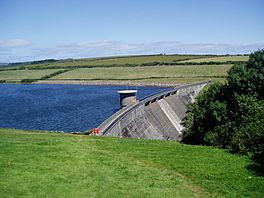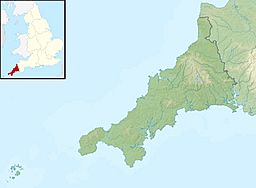Drift Reservoir facts for kids
Quick facts for kids Drift Reservoir |
|
|---|---|
 |
|
| Location | Cornwall |
| Coordinates | 50°06′29″N 5°35′28″W / 50.1080°N 5.5910°W |
| Type | reservoir |
| Basin countries | United Kingdom |
| Max. length | 1,200 yd (1,097.3 m) |
| Surface area | 65 acres (26 ha) |
| Max. depth | 48 ft (14.6 m) |
| Water volume | 1,200 million L (260 million imp gal; 970 acre⋅ft) |
| Surface elevation | 275 feet (83.8 metres) |
Drift Reservoir is a large, human-made lake in Cornwall, England. It is located just north of the village of Drift and west of Penzance. This important reservoir is about 1,200 yards (1,097 meters) long. It covers an area of 65 acres (26 hectares). The reservoir's main job is to supply drinking water. It provides water for the entire Penwith area of Cornwall. A large dam is found at the southern end of the reservoir. The northern end splits into two shallow arms. The South West Lakes Trust and South West Water work together to manage the reservoir. People can visit the dam and a special parking area.
Building Drift Reservoir: A Look Back
Why Was the Reservoir Built?
Plans for Drift Reservoir were first approved in 1938. This was done under a special law called the Penzance Corporation Act 1938. However, building work had to wait. It was put off until after World War II ended.
Starting the Construction
In 1951, the councils of Penzance and St Ives agreed on a plan. They wanted to provide water for the whole Land's End peninsula. Work on the reservoir finally began on March 1, 1959. The company Robert Alpine and Sons carried out the construction.
Challenges During Building
During the digging, builders found some rotting granite. This meant the original design had to be changed. The reservoir was completed in 1961. It was built for the West Cornwall Water Board. Today, it is still the main source of water for the Penwith area.
The Lost Valley
Before the reservoir was built, there was a valley called Trewidden Vean. People now call it the Lost Valley. Families living there had to move out starting in 1938. The last family left in 1961. All the trees were cleared from the valley. Most of Nanquitho Farm and its farmhouse are now under the water.
Sometimes, the water level in the reservoir drops very low. When this happens, you can see the remains of old houses and roads. This has happened a few times, including in the 1970s, 1990s, and in the summer of 2018.
Wildlife and Nature at Drift Reservoir
Early Life in the Reservoir
In 1962, the reservoir was first filled with fish. About 8,000 rainbow trout (Oncorhynchus mykiss) were brought in. They came from Loch Leven trout fisheries. Many buckets of shrimps were also added from Stithians Reservoir.
Birds of the Reservoir
At the start of the 21st century, many birds lived at the reservoir. There were over eighty mute swans (Cygnus olor). Many Canada gooses (Branta canadensis) were also present. People used to feed them old food from a local bakery. However, feeding was stopped to protect the fish and keep the water clean. This was requested by the Bolitho Estate.
A Special Place for Migrating Birds
Drift Reservoir is very important for migrating birds. It is close to the sea and has shallow water and muddy areas. These features make it a great place for waders to land and rest. The Cornwall Birdwatching and Preservation Society (CBWPS) manages the north-west arm of the reservoir. There is a special bird hide there. It is only open to members of the CBWPS.
Protecting the Birds
To help the birds, a "no fishing" area was created in 2001. This was in the north-west arm. A reed bed of Phragmites australis was also planted. A year later, it was clear this helped breeding birds. These included common coot (Fulica atra), mallard (Anas platyrhynchos), and mute swan.
Rare Bird Sightings
The reservoir usually has small numbers of birds. However, 244 different species have been recorded there. It has attracted many rare birds from North America. These include lesser scaup (Aythya affinis). These birds are called vagrants because they are far from their usual homes.
In May 2016, a Dalmatian pelican (Pelecanus crispus) was seen in western Cornwall. This large bird was often spotted at the reservoir. There are 5,000-year-old fossils of this type of pelican from Somerset. This recent sighting might be the first time this bird has been recorded in Britain since then! At the same time, a cackling goose (Branta hutchinsii) was also at the reservoir. This is another rare bird from North America.
Fishing at the Reservoir
Rainbow trout and blue trout are released into the reservoir for fishing. The native brown trout (Salmo trutta) also live there. An event called the Cornish open float tube competition is held every year in May.


